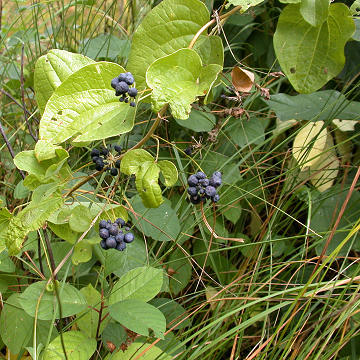

Smilax lasioneura - (image 1 of 5)
Taxonomy
Family: Smilacaceae
Habitat
Frequent in woods. Shaded dune slopes. Also in open habitats like clearings, old pastures, fencerows, and roadsides.
Associates
Allium tricoccum burdickii, Claytonia virginica, Crytotaenia canadensis, Galium aparine, Geranium maculatum, Hydrophyllum virginianum, Podophyllum peltatum, Polygonatum canaliculatum, Ranunculus abortivus, Ranunculus septentrionalis, Sanicula gregaria, Viola sororia.
Distribution
Mainly west of the Appalachians, west to MT, WY, CO and OK, and south to western FL.
Morphology
Herbaceous perennial vine, without prickles. Stems to 7' high, at least 3.5' when in flower, climbing by tendrils, normally freely branching. Flowers greenish; penduncles borne in the axils of leaves with fully developed blades, seldom more than twice as long as the subtending petioles. Fruit a blue-black, glaucous berry with 3-6 seeds.
Notes
Flowers early May to late July
Wetland indicator: Upland in the Chicago region
Some authorities call this plant S. herbacea var. lasioneura (Hook.) Rydb. Typical S. herbacea is completely glabrous and may be restricted to the Appalachian and Blue Ridge mountains. Plants with short-acuminate leaves, shiny green lower leaf surfaces, peduncles mostly 5-10 as long as the subtending petioles, and black fruit (var. pulverulenta [Michx.] A. Gray) occur from southeast NY to VA and western NC, west irregularly to IN, MO, eastern KS, and AR.
References
Gleason, Henry A. and A. Cronquist. 1991. Manual of Vascular Plants of
Northeastern United States
and Adjacent Canada. Second Ed.
The New York Botanical Garden. Bronx, NY
Swink, F. and G. Wilhelm. 1994. Plants of the Chicago Region.
Indiana Academy of Science. The Morton Arboretum. Lisle, Illinois.
|
Michael Hough © 2005 |